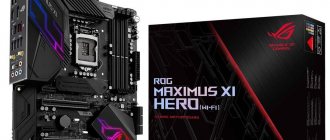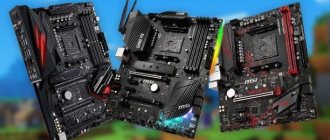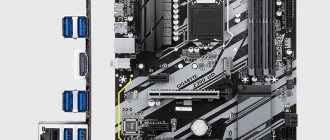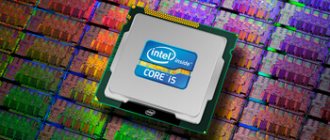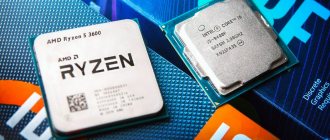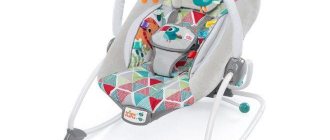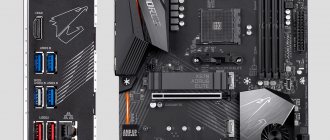Home » Computers
Editor's Choice
Vladimir 06/14/2021
Choosing the optimal motherboard for Intel Core i3/5/i7 processors
Are you going to upgrade your old computer or build a new one? Start by selecting a processor-motherboard pair. A motherboard for intel core i5 processors may be a good choice. The reliability and speed of your future PC depends on which board you choose.
Asus ROG STRIX B250I Gaming
Read also: TOP 7 Best sound cards for games, music and movies | Current rating 2021
Asus ROG STRIX B250I Gaming The ASUS ROG STRIX B250I GAMING motherboard is designed to work in conjunction with eighth generation processors. To install a processor, it has an LGA 1151 slot and an Intel B250 chipset.
- Memory slots
The motherboard has 2 dual-channel DIMM memory slots into which DDR4 RAM sticks are installed. The slot can accommodate memory operating at up to 2400 MHz with Kaby Lake processors and at 2133 MHz with Skylake processors. Each slot supports up to 16 GB of RAM.
- PCI slots
The motherboard has only one PCI slot - E3.0 x16.
- Connecting hard drives
You can connect up to 4 hard drives to the motherboard, which connect to SATA III ports. There are also two M.2 ports that support SSD devices in the M.2 2242, M.2 2260 and M.2 2280 formats.
- Interfaces for connecting external devices
Two USB2.0 ports and four USB3.1 Gen 1 ports are provided for connecting peripheral devices.
- Peculiarities
The motherboard has a high-quality ROG SupremeFX audio system. The audio subsystem contains an amplifier for reproducing sound through headphones.
Communication capabilities are provided by Gigabit Ethernet controllers from Intel and Wi-Fi 802.11ac with a 2 x 2 antenna. This technology allows you to achieve an abundance of information at speeds of up to 867 Mbit/s. The Wi-Fi controller supports the new MU-MIMO technology, which makes it possible to connect several clients to it simultaneously at maximum speed.
The device in question has a small two-tier heatsink that simultaneously cools both the chipset and the SSD drive installed in the M.2 slot.
In addition, the motherboard has the ASUS Aura Sync LED system, which allows you to simultaneously connect several Aura devices. The backlight is controlled by a special utility, which is supplied on the disk included in the package.
Excellent sound quality is provided by the SupremeFX audio system based on the Realtek S1220A audio codec. It provides excellent recorded sound quality with a signal to noise ratio of 113 dB. Sound reproduction is carried out with a signal-to-noise ratio of 120 dB. In addition, the audio system includes Texas Instruments RC4580 and OPA1688 amplifiers, which have low distortion levels.
This motherboard comes with two utilities. Sonic Studio III is designed for fine-tuning the sound subsystem. And also Sonic Radar III which allows gamers to visualize the source of the sound, even if it is out of sight. In this case, the arrow indicates the direction of the sound source.
- Bottom line
Based on this motherboard, you can create a compact and fairly powerful gaming computer.
Current price STRIX B250I
VIDEO: Unboxing Asus Strix B250I Gaming
Asus Strix B250I Gaming Unboxing
TOP 8 Motherboards for a series of Intel Core i3/i5/i7 processors on 1151 sockets: choosing the best option in 2021
How to choose a motherboard for Intel i5 10400F
Buying an inexpensive motherboard under $100 for the Intel Core i5-10400F is not justified. Installing a processor in the socket of a premium motherboard (under $300), you will be pleased with the performance increased by up to 15% and an increase of up to ten FPS in games compared to a cheap motherboard.
The reason is in memory - on cheap boards it operates at a maximum frequency of 2667 MHz. More expensive motherboards that support frequencies from 3400 MHz will reveal the potential inherent in the processor.
The Z490 chipset with aggressive XMP profiles for overclocking RAM is a gift for gamers and overclocking enthusiasts. Another advantage of motherboards based on Z490 logic is support for combinations of graphics adapters for assembling powerful gaming systems.
conclusions
You can get a 10-15% performance boost with the Intel Core i5 10400F only on motherboards with the Z490 chipset running memory at frequencies above 3400 MHz. Motherboard manufacturers offer dozens of gaming solutions at different prices, among which we have selected those that are worth your money. What do you think, which motherboard to choose i5 10400f? Write in the comments!
If you find an error, please select a piece of text and press Ctrl+Enter.
Related posts:
No related photos.
Rate this article:
( 14 ratings, average: 2.43 out of 5)
Tweet Pin It
about the author
immkg
- Alex 01/06/2021 Reply
Judging by a similar list of motherboards, it can be said that the author is a fool, for a processor that does not support overclocking, taking motherboards on the z chipset is critical. You could also install a pentium chipset on the z, but what about the board, but the processor is not very good. - Anton 04/09/2021 Reply
I agree with the comment from ALEX, the author has absolutely no knowledge of components, he recommends something that will work at idle
- Alexey 05/10/2021 Reply
ALEX and Anton are mom's pickers. Your brain is running idle. The Z490 is not taken to overclock the processor, but to get functionality that is not available on lower-end chipsets.
- Senya 07/05/2021 Reply
Hey, you knowledgeable people, where is your good advice on which motherboard to use with the above processor!
- Mykola 07/08/2021 Reply
Yeah, buying a motherboard 3 times more expensive purely for a “15%” increase in performance is certainly cool. I hope the author got a good paycheck for PR for extremely expensive motherboards with a z chipset, completely unnecessary for the non-overclockable six-core 10400, because if he wrote this nonsense for free, then I can only sympathize... well, maybe he’ll even throw in some money for treatment. But no, I can’t, because I spent all the money on an expensive motherboard for a processor for 12k! 11 mini-ATX motherboards with 2 RAM slots for 24k out of 10
- Imposter 07/08/2021 Reply
Amogus
- Rustam 07/21/2021 Reply
Lol, the author wrote about memory overclocking in general and not specifically, it doesn’t drive shit in chipsets
- Alexander 08/08/2021 Reply
Why waste memory??? I take a percentage, which is essentially cheap, in order to take the mother more expensive than the percent and drive away the memory? So I’m an idiot... If we take the mother for 17, then maybe we should still take the percentage that is not the budget at all? Then give yourself a percentage and memory... Personally, I’m now looking at the 10400F for its price (12,000 as of 08/8/21) and at the 10th generation. And therefore F, so that it would be even cheaper, because I have an old video card, but it’s better built-in even in the 10s. Why do I need such a mother? Mother I watch 6-7k. 2 memory sticks of 2666 are enough for me, because the stone has 2 CHANNELS AT FREQUENCY 2666, has anyone looked at the performance characteristics? What the hell are you overclockers going to drive there...
- Alexander 08/08/2021 Reply
This entire article is generally unclear for whom and why it was written. The 10400F stone itself is not driven in the usual sense. The memory operates at a frequency of 2666, what should I drive there? The mother is under 1200, if I’m not mistaken already from 2666. There are 2 channels, a mother with 2 slots is enough. For a cheap stone there is nothing to fence, maximum 2x16. Personal opinion, for the 10400F you need a mother of 6-8k maximum. Any H460-H470 and 2 sticks of 8, maximum 16GB. Which is exactly what I'm planning. If you want to drive something but for a minimum, then take 10600K for !!! 18,000 rubles.
- Tonchik 09/07/2021 Reply
You go to the first link of the request and such a sadness comes over you: such a contrast between the article and the comments, and what can I do, I just need to update my computer from the 3rd generation i5... And here again overclocking, again some kind of gaming smokehouse ((
ASRock B560M-HDV
- Form factor: Micro-ATX
- Socket: LGA 1200
- Chipset: Intel B560
- Number of memory slots: 2
- Memory channels: 2
- Maximum memory: 64 GB
- Number and type of SATA ports: SATA III – 4
- Number of M.2 connectors: 1
- PCI-E slots: PCI-E x16 – 1, PCI-E x1 – 2
- Connectors on the rear panel: LAN, HDMI, DVI-D, VGA, USB 3.0 – 4, USB 2.0 – 2, PS/2, mini Jack – 3
- Additional connectors and interfaces: USB 3.0 (on board) – 2, USB 2.0 (on board) – 4, 4pin – 4
- Audio: Realtek ALC897 7.1
- Network interface: Intel I219V, 1000 Mbps
ASRock B560M-HDV is one of the most budget motherboards based on its chipset, and its main advantages, like other models based on the same system logic set, are support for manual overclocking of RAM and the fourth version of the PCI Express interface. Taking this into account, in most cases it has become irrational to buy models based on the B460 - the exception is those cases when a motherboard on an old chipset costs much less, then it can be used for a gaming build - however, not at a very high level: after all, in serious gaming applications configurations, I would like to see RAM operating at a frequency of 3600 megahertz or higher.
But let’s return to the board in question. It offers only 2 slots for RAM modules and 4 SATA for SSD and HDD, but, importantly, it also has one M.2 port on board, allowing you to use an ultra-fast solid-state drive in the system. At the same time, I note that the solution also has disadvantages - in addition to only 2 slots for RAM, there is the absence of a heatsink on the power subsystem, but with six-core processors, provided there is no side airflow, problems should not arise, and in general, the advantages of the B560M-HDV , taking into account the price, clearly outweigh.
Choosing a motherboard for Intel processors - what you should pay attention to
Choosing a motherboard is no less important a process than choosing a processor or video card, because it will be responsible for how the rest of the elements in the system will work, and what components you can put in your PC.
And in today’s article we will look at boards for processors from Intel (of course, the latest generation - Coffee Lake and Skylake-X) - from the simplest and most budgetary to sophisticated and expensive solutions for the HEDT segment. Entry level - Intel H310
This is the simplest modern chipset from Intel, and it is on it that the cheapest motherboards for the LGA1151v2 socket are built: their price tag on average fluctuates around 4-5 thousand rubles. What do manufacturers offer us for that kind of money?
Firstly, it supports any processors on this socket, from Celeron to Core i9. There is obviously no overclocking - the chipset is budget (alas, there is no way around this). In fact, everything is so: all these processors are recognized by H310 boards and will work, but not very well: the vast majority of such boards have only 3-4 phases of processor power supply (VRM), devoid of heatsinks, so give the same Core i9 simply won’t be able to provide the 150-200 W it needs under load, heating up to more than a hundred degrees, forcing the processor to reset the frequency.
Therefore, a reasonable maximum is dual- and quad-core processors, that is, Celeron, Pentium and Core i3. In principle, you can “swing” at six-core processors with a thermal package of 65 W, but there is no point in this: even the simplest Core i5-8400 requires more than 80-90 W under load, that is, the established limit of 65 W will slightly reduce its performance ( and if the restriction is removed, then there will be serious heating of the VRM). Well, taking into account the price of such CPUs, it makes sense to pay an extra couple of thousand rubles for a good board on an older chipset and not lose performance.
As for RAM, not everything is good here either: there are only two slots for it. Of course, on the one hand, this will give a volume of up to 32 GB, which is a lot even for a Core i3. On the other hand, if we consider a typical case with the purchase of two 4 GB sticks, then the upgrade in the future will force you to sell one (or both) of these sticks. Therefore, taking into account the already not the highest CPU performance, it makes sense to take one 8 GB die, and in the future pair it with another one of the same kind - this will be an excellent volume for such a PC. Alas, there is no memory overclocking: although, in general, with such CPUs the gain from this would be negligible.
One thing can be said about everything else on the board - a reasonable minimum: there is only one PCIe x16 slot, and even if there are two PCIe on the board, SLI or CrossFire will not work. The number of USB ports ranges around 4-6 - again, this should be enough for a basic level PC. The audio card is mostly a built-in Realtek ALC887 (or ALC892): it is quite capable of producing better sound than most smartphones, but it is significantly less than the ALC1220 in more expensive boards. The network adapter is a gigabit one from Realtek (fortunately, no one has installed a 100 Mbit/s adapter for a long time), that is, this is enough for the vast majority of users. There are about 4 SATA ports, that is, it is quite possible to connect an SSD for the system and a couple of disks for data storage.
A typical board based on the H310 chipset for processors no higher than Core i3.
As for the answer to the question in the title of the article - what is worth paying attention to - the answer is simple: only to various connectors and ports and nothing more. Why? It's simple: the circuit design of such budget boards is slightly different, and an extra power phase or PCIe x1 slot is unlikely to help you. Therefore, it makes sense to look at the content of the boards in terms of connectors and ports: for example, you have an m.2 SSD - it makes sense to overpay a little for a board with such a connector. Or, for example, your TV is connected via VGA - again, you should look for a board that has such a video output. In all other respects, all motherboards based on the H310 are very similar, so there is absolutely no point in overpaying an extra thousand rubles for a brand like ASUS or MSI: in fact, solutions from the same ASRock will differ only in the label and nothing more.
Mid-range segment: Intel B360, Q370 and H370
As is usually the case, there are minimal problems with the budget and top-end segments, because the choice is small. But in the middle segment, “the devil will break his leg” - there are only three chipsets. All of them support the entire line of Coffee Lake processors, but, alas, there is no overclocking either. As for the power circuits, everything is quite simple: firstly, there must be a heatsink, because, as I wrote above, six- and eight-core CPUs from Intel are quite hot even without overclocking. In terms of the number of power phases, everything is a little more complicated: if you are not considering buying an 8-core Core i7 or Core i9, then a solution with 4-6 phases is quite enough, because with a load of 100-120 W for the same Core i7-8700K they will cope. If you want to take an 8-core CPU, then 6 phases are the minimum, because such processors can easily consume over 150 W even without overclocking.
This is what will happen if you put a top-end processor on a simple board. Photo from 3Dnews website.
You should also understand that if you take a Celeron, Pentium or even a Core i3, and do not plan a further upgrade, there is simply no point in buying motherboards on these chipsets; with a high degree of probability, you will be able to eyeball the capabilities of the simpler H310 chipset.
There can be 2 or 4 slots for RAM, respectively, the maximum is 64 GB (however, some manufacturers have already introduced support for memory sticks with 32 GB of memory in the BIOS, that is, in this case the maximum amount of RAM increases to 128 GB). There is no particular point in taking a board with two slots - you will often save less than a thousand rubles and will seriously complicate your upgrade in the future (since you can take, for example, two fairly cheap 8 GB dies at the start, and then add two more in the future, thereby getting substantial 32 GB for an acceptable amount). Unfortunately, the memory still cannot be overclocked, which can be critical in conjunction with powerful processors - for example, in some games, using DDR4-2666 instead of DDR4-3200 reduces fps by 7-10%, which is quite significant.
But further on, quite noticeable differences begin between the chipsets. Thus, the Q370 allows you to split 16 PCIe lanes into parts, for example into two 8 lanes each or into three: 8+4+4. So this chipset is the cheapest option for creating a system with two or three video cards in SLI or CrossFire.
Also, the youngest among these chipsets, B360, cannot work with RAID arrays - if this is important to you, you should take a closer look at the H370 or Q370. In addition, the maximum number of possible USB 3.0 ports also varies: from 10 for the B360 to 16 for the Q370.
Moreover, audio cards and network adapters differ: the former can be represented either by the simpler Realtek ALC887 or ALC892, or by the more advanced ALC1220: if you use good on-ear headphones, the difference in sound quality will be clearly noticeable. As for network adapters, there may be solutions from Realtek and Intel: they all support speeds up to 1 Gbps and work well, so there is no point in getting hung up on this.
An example of an excellent board on the B360 chipset for building a PC with a top-end processor without overclocking and one powerful video card.
Taking into account the fact that it is quite possible to take the same Core i7-8700 for such boards, which works without problems even with Nvidia RTX 2080 Ti, it makes sense to look for solutions with a metallized PCIe slot: top video cards can weigh more than one and a half kilograms, and this weight with Over time, a regular plastic slot may bend. Of course, metallization is needed only for heavy (usually top-end) solutions - for some GTX 1060 with a reference design it is superfluous. Also, you should not overpay for boards with metallization of RAM slots, because even with radiators, the dies are not so heavy as to damage them.
What's the result? If you are building a “standard” system with one video card and no RAID, and you are not going to connect 10 USB devices, there is generally no point in looking at the chipset. The most important thing in this case is to have 4 RAM slots for the future and definitely heatsinks on the CPU power supply circuits. If you are also going to heavily load the processor (for example, use AVX instructions), it makes sense to buy a board with at least 6 VRM phases.
High-end segment: Intel Z370 and Z390
Everything here is quite funny: in fact, the only difference between these chipsets is that the second one is built on a thinner technical process (14 nm versus 22 nm), and also has built-in Wi-Fi and Bluetooth - on the Z370 this required a special separate adapter. That's it, there are no more differences: both support overclocking the processor and RAM, as well as SLI/Crossfire. Therefore, when looking for a board, it makes sense to select both chipsets - even if you take the top Core i9-9900K, it will work on the Z370 without any problems (which is not surprising - it also works on the simplest H310).
Obviously, it makes sense to take boards with these chipsets only if you are interested in overclocking the processor and RAM (and, let me remind you, only CPUs with the K index are overclocked) - otherwise, it makes sense to take the Q370 chipset, the only difference from which is from the Z- rulers - no overclocking. All other features, such as creating RAID arrays or connecting video cards in SLI/CrossFire, are present. Therefore, all the information below is intended for those who will overclock the CPU.
Overclocking imposes very strict restrictions on VRM: firstly, it is simply necessary to have a radiator, and not a simple aluminum “slapper” weighing ten grams, but a large plate. Secondly, if you plan to overclock a 4-core CPU (Core i3-8350K), then 4 power phases will be enough for it. For 6-core CPUs (Core i5, Core i7-8700K), it makes sense to take motherboards with 6-phase power supply, because consumption during overclocking can be higher than 150 W. But with the 8-core Core i7-9700K and Core i9-9900K, everything is literally very bad: even with the slightest overclocking to 4.8 GHz on all cores, you risk seeing heat dissipation of over 200-250 W in tasks with AVX instructions. When overclocked to 5 GHz, this figure can exceed 300 W, so to overclock these “stones” it makes sense to use only top boards with 8-10 or more power phases, and, preferably, airflow. On the other hand, if you don’t plan to run anything heavier than games, then you can get by with simpler boards with 4-6 phases, because games load the CPU much less.
Want to overclock the Core i9-9900K? You'll have to fork out money for this solution.
As for RAM, everything is the same as in the mid-level segment: it is advisable to take a solution with 4 memory slots. On the other hand, if you are building a compact mini-ITX system with only two slots, you can immediately take two 16 GB dies - most likely, this will be enough for the entire life of the system.
It is also worth paying attention to the metallization of the PCIe slot - everything here is exactly the same as with the mid-level segment. If we talk about the rest of the content of the board, then everything is purely optional, but taking into account the top-end features, you can expect anything, such as backlighting of everything and a built-in water block. Another important thing to note is the lack of Wi-Fi in the Z370 chipset by default, as well as the smaller number of USB 3.0 it has - 10 versus 16 in the Z390.
With audio cards and network adapters, everything is almost the same as in the mid-level segment: the first are either Realtek ALC887/892 or ALC1220. But with network adapters there is more variety: in expensive solutions there may be 10-Gigabit solutions from Aquantia - this can be useful for fast data transfer over a local network (if, of course, other devices also support 10 Gbit).
As a result, the key point here is the VRM zone, everything else is very secondary and optional.
HEDT segment: Intel X299
This is the maximum performance that can be achieved in a desktop computer: processors with up to 18 cores and up to 44 PCIe lanes are offered here. Obviously, such processors are expensive (more than $1000), so they are far from widespread - due to That's why there is only one chipset here, Intel X299.
However, there are pitfalls here too: for example, Intel, along with processors with 6-18 cores, for some reason released solutions with 4 cores: Core i5-7640X and Core i7-7740X. In essence, they are no different from their “home” counterparts, Core i5-7600K and Core i7-7700K, and are strikingly different from Skylake-X representatives (for example, they can only work with 16 PCIe lanes and 2 RAM channels), so some companies released special X299 boards only for these two processors. They are cheaper than those that are compatible with the entire HEDT line, so when buying, be careful and carefully monitor whether the chosen board supports your 18-core Core i9 or not.
18 cores are no joke; you shouldn’t skimp on the board here.
Obviously, in this segment there is no point in cutting down any capabilities, so the X299 chipset supports overclocking processors (all Skylake-X representatives are racing). Taking into account the fact that rarely anyone uses such CPUs for games, and various calculations can significantly load the processor - again, everything depends on the power supply circuit. So, the real heat generation during operation can be considered a figure of 200-250 W, so it is highly desirable to have at least 8 phases in reserve. There is no need to talk about radiators - fortunately, all boards in this segment have them by default.
Another important difference from ordinary “home” boards here is the number of RAM slots: now 4 is the minimum, and the maximum is 8. There is no point in recommending a specific number of slots, because each has its own tasks: if you need a lot of memory , then your choice is 8 slots of 16 GB - as much as 128 GB of RAM. Otherwise, you can get by with 4 slots up to 64 GB.
Regarding audio cards and network adapters, the situation is the same as with the Z-line: there are cheaper solutions on the Realtek ALC 800 line, and more expensive ones on the 1200 line. You can also find boards with 10 Gigabit Ethernet if desired. In other elements on the board, the differences are less global: the number of USB, PCIe x16 slots, SATA and Ethernet ports can be different - here everyone chooses according to their tastes and needs. As a result, the most important point is that specific boards support the CPU you need, as well as good power circuits.
